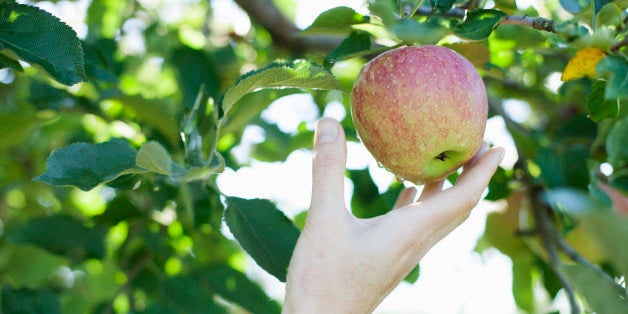
What is gleaning?
Gleaning is the process of collecting excess farm crops for distribution, but is being used to describe the more general practice of food recovery, where many kinds of food, including packaged perishable and non-perishable goods, are collected and distributed to the hungry and poor.
Why is this my problem?
One in six Americans struggles with food insecurity. Yes, we said Americans. Yet 40 percent of all food goes to waste. While a good part of that percentage is derived from people throwing out half-eaten grub, another significant chunk of waste is generated far before a meal reaches a diner's plate.
Wait - how is food wasted before it's even served?
In the U.S., around 6 billion pounds of "ugly" but perfectly edible produce is thrown out each year. Due to grocery beauty regulations, odd-shaped fruits and vegetables aren't piled in supermarket rows. As any farmer--and ahem, most chefs--know, nature isn't perfect. Strawberries can look bulbous, carrots can be angular, cucumbers can grow in an amoeba-like form. These foods and vegetables are known as "imperfect" or "ugly," though they taste the same as their beautiful counterparts.
As a result, in America, as much as 50 percent of any particular crop may be tossed out because of looks. This is a wasteful for a number of reasons. Firstly, excess crops could provide much-needed meals. Secondly, all the water, labor and fertilizer used to cultivate and harvest those crops are also lost. Thirdly, by squandering possibly half of a yield, farmers do not maximize profits. There are people creating businesses based on using ugly or bruised produce or turning it into fertilizer, but one of the easiest things you can do is tell your farmers and suppliers you want the ugly stuff.
These small steps can have a big impact: Only about 10 percent of available, edible wasted food is recovered each year in the United States; an extra 15 percent in saved food could feed over 25 million people.
OK, so how do I donate leftover food from my restaurant?
There are several ways to participate in gleaning programs. While food waste is a complex issue (read my guide to food waste here), gleaning is a great way for restaurant owners and chefs to get involved.
Firstly, you can donate any unused foods to food banks. (Check out the app Spoiler Alert to easily see how you can make donations.) Secondly, you can cook with imperfect or ugly ingredients, which will support local farmers. Several programs exist around the nation that will either take unused produce, or sell you gleaned produce at a discounted rate.
In New York, you can contact Rescuing Leftover Cuisine, a nonprofit that picks up excess produce from New York City restaurants. (As of May 2015, the group has redistributed over 100,000 pounds of food to homeless shelters and food kitchens across the city.) If you're in the Bay Area, check out Imperfect. They sell boxes of misshapen farm-fresh produce to consumers for 30 percent less than traditional produce. They're also partnering with supermarkets on a branded line of imperfect foods. If you work on a college campus, look to Food Recovery Network. They collect uneaten produce from universities across the nation.
The Society of St. Andrew, the largest gleaning group in the U.S., harvests or gathers 30 million pounds of food each year to distribute to a network of pantries. Feeding America is another national food recovery organization to get in touch with.
There are several local gleaning programs across the nation. See what's happening in your community--how you can pair up with local farmers to take advantage of their excess crops, and food banks to see how they can use your excess ingredients.
Aren't I liable if someone claims to get sick from food I donated?
One of the biggest barriers to food recovery is perceived liability. "The Bill Emerson Food Donation Act, signed into law by President Clinton in 1996, protects donors from food-safety liability when donating food to a nonprofit organization," notes the Natural Resources Defense Council. "However, awareness about this law and trust in the protections it offers remain low. Even if protected by law, some companies may fear negative publicity if donated food causes illness."
Do other countries have gleaning programs?
In 2014, the French supermarket chain Intermarche hosted a campaign to get people to buy "inglorious" produce at a discount. It was a smash hit. Several other supermarkets in France and across Europe (including Austria, Switzerland, Germany, Ireland, and the Netherlands), as well as Australia and Canada, have since run similar programs.
The French government recently passed a law that requires all supermarkets to donate unsold and unspoiled foods to charity; all spoiled food is to be sent back to farms for composting. Those who don't comply will face penalties and potentially jail time. No news on whether or not the law will expand to restaurants.
How can we make gleaning more popular?
Supporting your local food bank is one way--extra resources and volunteers are required for active gleaning programs. Additionally, pay attention to how your local government officials vote. Former tax incentives for food donation expired in 2011. Enhanced tax deductions for food donation could be made available for large and small businesses. The legislation to keep your eye on is called the U.S. Gives More Act.
Originally published at Plate Online.
___
Follow Eve on Facebook and Twitter @EveTurow, and read her blog, Generation Yum!